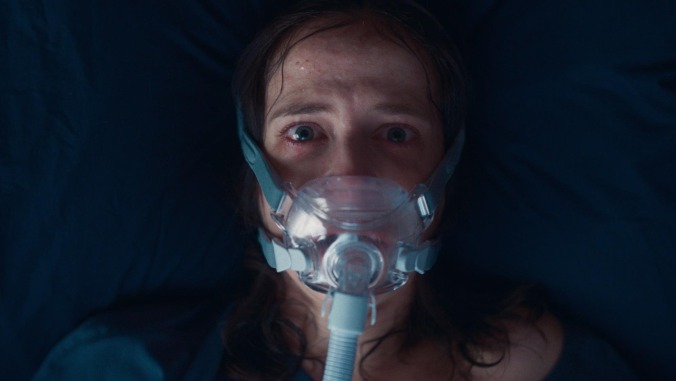Nocebo won't cure what ails horror fans
Even Eva Green and Mark Strong aren't enough to pad out this story of a fashion designer suffering from a strange—and possibly imaginary—illness

Photo: RJLE
If you didn’t already know that the star of Nocebo was named Eva Green, plenty about the movie might suggest it: she wears green, her character’s house is painted green on the inside, and she spends most of the movie “green around the gills,” as they say. Beset by illnesses that may be psychosomatic and/or supernatural, Green’s Christine is emotionally burdened by an incident eight months prior, which initially remains mysterious aside from the fact that it involves multiple bodies. Not to mention the plague-ridden dog that showed up and shook ticks all over the room, one of which bit her (if, in fact, it was real). The dog vanishes, but the bug bite persists.
The immediate inclination of horror viewers in a post-Shyamalan world might be to search for hints that either her husband Felix (Mark Strong) or daughter “Bobs” (Billie Gadsdon) is really dead, persevering only as a hallucination. But once it becomes clear what Christine does for a living—designing kid fashion that she finds “inspiration” for all over the world—and Filipina caregiver Diana (Chai Fonacier) shows up unexpectedly on her doorstep, the answers begin to unearth themselves pretty quickly.
Though not as commonly uttered as its antonym, “nocebo” is a real term for a non-effective treatment that psychosomatically harms a person. It doesn’t quite apply here—if anything, both Christine’s pills and Diana’s folk remedies make her feel better. But once Diana acknowledges the tick, and catches it in a matchbox, no less, things take a sinister turn: perhaps the cure is merely a set-up for an even worse condition.
Because what’s going on is quickly obvious to anyone paying even loose attention, Nocebo ultimately becomes a bit of a patience test in the same way as the many other Blumhouse movies about people wandering around an empty house in search of noises. Since it’s obviously not going to resolve until the end, viewers must slowly take in a great wealth of exposition they’ve likely guessed at in advance. Director Lorcan Finnegan at least throws in a couple of visual swerves which, along with the cuckoo metaphor of his last film, Vivarium, suggest a baby bird must have seriously traumatized him at some point in his life.
Finnegan also leans hard on creepy kid cliches. Bobs is the first to witness evidence that Diana is not as she seems, but may have malicious intent. Yet she chooses to side with Diana, and proves to be unhelpful and conveniently silent when her parents are seeking answers. Consequently, she seems like kind of a jerk—again, a running theme for the director. Though to be fair, Christine’s counterproductive relationship with other children also hastens the suffering she endures.
Ticks are inherently scary to anybody who has known the ravages of Lyme disease, and Finnegan takes full advantage of this—without ever suggesting that Lyme might be the problem. With the aid of some perspective shifts and a CPAP machine, he expertly creates one sequence featuring a nightmare whose victim cannot scream for help. For Sandman fans underwhelmed by the Netflix adaptation’s exploration of the curse of eternal waking, this film explores that idea as well. Green, frequently known for playing characters who use their good looks to their advantage, sheds all of that to look constantly worn out and traumatized. Without many outstanding traits to latch on to, she generates sympathy mainly by enduring a level of omnipresent stress to which no human should be subjected.
The character of Diana seems rooted in the Filipino black magic art known as kulam, involving sympathetic magic and the use of beetles. Finnegan and his Vivarium writer Garret Shanley seem to have fictionalized the concept a bit with a new name, possibly to avoid real curses being put on themselves. But they’ve done their homework to avoid caricaturing these rituals; Diana may seem or even sound like a villain, but a big part of the movie’s conceit is changing perspectives so that conventional definitions of good and bad become irrelevant. Even picking a protagonist by the end may become a matter of opinion.
Unfortunately, the end doesn’t come quite soon enough. What would have made a great Tales From the Crypt episode becomes overlong even at 96 minutes—Lost-style flashbacks add depth but not revelation, as they merely make graphic what was already implicit. The “mystery” elements simply aren’t mysterious. Yet without them, the sparse moments of gore and icky bugs aren’t quite enough to pad things out.